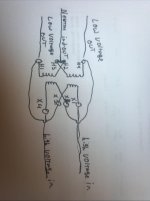Rmkscrambler
Plastic
- Joined
- Jun 18, 2013
- Location
- Utah USA
Ok single phase power from the street is 125/250 vac I have to run a RPC to get 3 phase My machines want 245 vac3 max. So I bought a single phase 12/24 buck boost to put before the RPC. If I wire it according to the diagram on the Buck/boost it will only drop one line. So I will have one leg at 101vac to ground and one leg at 125vac to ground. As far as the 3 phase delta goes the RPC should balance out close enough line to line.
But I'm not fond of having the single phase imbalance. I talked to the supplier I bought the buck boost from about buying a second and putting one on each line. He suggested that I wire it according to this diagram. He also said he has never seen it done and non of the manufacturers show it as an option but it should work. According to my understanding it looks like it should work. Each winding is carrying the same current, and both legs come out with the same reduction. I have wired it up this way just to test and voltages are good 113/225 on out put.
So am I missing something? The only problem I can think of would be an increase in heat but because current is the same it should be fine.

But I'm not fond of having the single phase imbalance. I talked to the supplier I bought the buck boost from about buying a second and putting one on each line. He suggested that I wire it according to this diagram. He also said he has never seen it done and non of the manufacturers show it as an option but it should work. According to my understanding it looks like it should work. Each winding is carrying the same current, and both legs come out with the same reduction. I have wired it up this way just to test and voltages are good 113/225 on out put.
So am I missing something? The only problem I can think of would be an increase in heat but because current is the same it should be fine.





